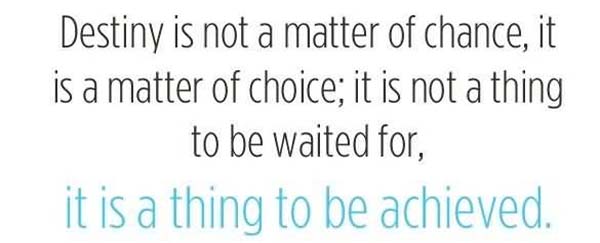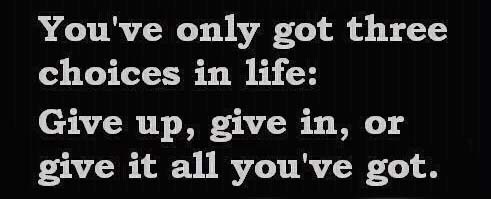Success Advice
How To Ditch Your Dilemmas And Make Kick-Ass Decisions
Ever had that feeling of being stuck between a rock and a hard place?
There is no doubt you’ve had sleepless nights turning the problem over in your mind, wishing for a way out.
Wishing someone else could swoop in and change it for you.
Fantasizing that if only so-and-so would yield and do such-and-such… then everything would be ok.
But we’re old enough and wise enough to know that is rarely what happens.
Sometimes you just have to make a tough decision.
Sometimes it involved sacrifice.
And sometimes we lose a piece of ourselves in the process.
But What If I Told You It Didn’t Have To Be That Way?
What if you had a process to get out of any catch 22 situation and still walk away with what you want, and everyone else be happy?
There is a way, but it may mean shifting your perspective on how you think the world works.
You see, in my experience, most folks (and I’m talking intelligent, high achieving folks who can think for themselves) have come to the conclusion that the world is concrete.
I blame classical physics for this.
If x happens, then this leads to y, p times out of q.
And this is fine.
If life were that simple.
And some of us have hypnotised ourselves with pretzel logic to believe that it is.
Newsflash.
It’s not.
“Life is complex. Messy. Rough around the edges… but totally malleable” ReTweet This
Life is complex. It’s messy. It’s rough around the edges, and squidgy in the middle. It shifts, it turns, it surprises you and disappoints you and thrills you – often all simultaneously.
There are sooooo many variables in any situation you’re facing, there is no such thing as x leads to y.
And thinking that way keeps you stuck.
Thinking that way limits your options, your creativity and the quality of experience you will allow yourself to have in your world.
You essentially box yourself in to a limited, “inevitable doom”.
(Which, incidentally, you also created in your mind first!)
How To Think Of Your World
Instead of things being set in stone, think of them as yielding gently to your choices, and your thoughts.
Try thinking of the world as malleable. Dynamic. Fluid.
You are indeed the creator of your reality.
On every level.
Start acting like it.
How?

Dang the Doom
Ok, take that catch 22 you’ve been thinking about. That situation you’ve decided there is no way out of.
Now, most probably it involves other people. And you’re worried that whatever decision you make, someone is going to be hurt, or upset, or react in a way you don’t want them to.
Right?
Right.
So here’s the solution.
And hang with me before you have a reaction, because this is only step one.
Step 1
Make the decision that will make you the happiest first. (Taking out of the equation anyone else’s opinions… at this first stage).
Got it?
Ok, write it down. You need to commit this to paper so you can’t wiggle out of it and conveniently “forget” what would make you happy.
(Believe me, I’ve seen this happen in front of my very eyes on coaching calls… the subconscious can be sooo sneaky!)
Right – on to step 2.
Step 2
Practice putting all your attention on your happy outcome. Every time worries about other people, and “potential” (read: dreamt up, imagined, construed) downsides spring to mind, just drop those thoughts, and return to the happy thoughts.
Laver, rinse, repeat….
Several times per day.
Seems too simple huh?
Try doing it. Not so easy. But with a bit of practice you’ll get it, and you’ll find your groove and make magic happen.
But I Don’t Want To Upset Anyone!
So often folks will shy away from choosing their happy outcome because they want to keep everyone else happy. And whilst this is admirable, and yes, compassionate – there is a flawed premise.
This assumption that you’re leaning back on, presupposes that you can control other peoples’ happiness.
You cannot.
You can only influence your own. And by you being happy, you make those around you even happier.
You empower them.
You inspire them.
You show them that they too can get out there, be who they really are, do what makes them happy, kick some ass, and take some names…. (in a positive way, of course, lol..)
No more co-dependence.
No more zapped energy.
No more catch 22.
Quod Erat Demonstradum.

Here’s the thing:
1. If someone wants to be a victim, no matter what YOU do, they’re going to achieve it… one way or another. So shed that burden right now.
2. If you think about something bad happening, or someone having a problem with your decision, you will flat-out create that. Every time. No question.
3. If your decision directly affects another, as long as you are taking the happy decision aligned with your highest intention, and the biggest you possible, you can’t hurt anyone. It’s like when you’re vibrating at a high frequency, the folks who don’t match your frequency spin-off. They can’t get near you. And if your decision isn’t in line with their highest good, their frequency won’t match yours and they won’t be affected by you. They’ll spin off and have their adventures elsewhere, and be unaffected by all the horrible things you’ve dreamt up to create your dilemma.
So at this point, you may have questions about how to apply this to your specific circumstance.
Do feel free to ask away in the comments section.
Or even head over to my site and send me an email. I read every message, and I’m happy to help.
Oh, and you may want to print this article off, and pin it somewhere you can see it every day – as a reminder that you really are the creator of everything in your world. 😉
Here’s to your inevitable success!
Laura Leigh Clarke
a.k.a. the Whole Heart, Whole Brain Business Mentor
Wire Yourself for Wealth
Life
10 Research-Backed Steps to Create Real Change This New Year
This New Year could finally be the one where you break old patterns and create real, lasting change.

Every New Year, we make plans and set goals, but often repeat old patterns. (more…)
Change Your Mindset
The Silent Skill That Makes People Respect You Instantly
What truly earns respect and why most people go about it the wrong way

Everybody craves respect but not everyone earns it. Some people believe that a title, years of experience, or a position of authority automatically entitles them to respect. (more…)
Entrepreneurs
The Essential Skills Every Entrepreneur Needs In 2026
Success in the digital age isn’t about luck. It’s about mastering the skills that separate dreamers from doers.

When I was 22 years old, I started my first side hustle as a ghostwriter. (more…)
Did You Know
The Success Patterns You Inherited (And Didn’t Notice)
Your family history may hold the key to why you think, act, and feel the way you do today.

Who are you? Your experiences and your family’s narratives and legacies contribute to your identity. Your ancestry contains individual traits and forces that have been inherited over the years. It also carries the fights and victories of your forebears and older family members. (more…)
-

 Personal Development4 weeks ago
Personal Development4 weeks agoThis Silent Habit Might Be Sabotaging Your Career
-

 Business4 weeks ago
Business4 weeks agoWhy Your E-Commerce Fulfilment Is Probably Broken (And How to Fix It)
-

 Shift Your Mindset3 weeks ago
Shift Your Mindset3 weeks ago11 E’s That Define Every Great Leader And Why Most People Miss Them
-

 Did You Know3 weeks ago
Did You Know3 weeks agoThe Success Patterns You Inherited (And Didn’t Notice)
-

 Business3 weeks ago
Business3 weeks agoThe Hidden Money Pit in Your Operations (and How to Use It)
-

 Entrepreneurs2 weeks ago
Entrepreneurs2 weeks agoThe Essential Skills Every Entrepreneur Needs In 2026
-

 Change Your Mindset2 weeks ago
Change Your Mindset2 weeks agoHow to Turn Your Mind Into Your Greatest Asset (Instead of Your Enemy)
-

 Change Your Mindset1 week ago
Change Your Mindset1 week agoThe Silent Skill That Makes People Respect You Instantly

























10 Comments